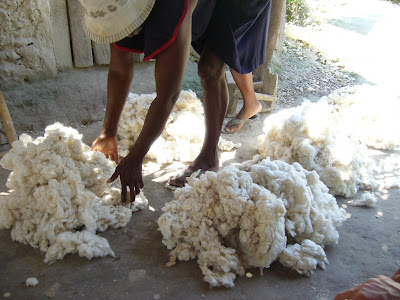
So, to start getting to the point (hint: it's not baby ducks...) of why I am here in Deschapelles, I thought I'd share this picture of a picture with you. This is Albert Schweitzer. There are four pictures of Albert Schweitzer in the room where I am staying. Albert Schweitzer won the Nobel Peace Price in 1952. A young man of means, Larry Mellon, saw Albert Schweitzer on the cover of Life magazine, read the article therein, and decided to do like Dr. Schweitzer.
And what had Dr. Schweitzer done? The son of a minister in Upper Alsace, born in 1875, he studied philosopy amd thoelogy at the University of Strassburg, living for a time in the same house that Goethe (!!) had occupied when he attended Strassburg. He also studied music, ( he is playing the organ in the blurry photo above). He moved to Paris to study Philosophy and organ in 1898. There, and in Berlin in 1899, he prepared his Doctorate on the work of Immanuel Kant. He became a minister, wrote a book on Bach, and was an expert on organ building.
In 1905 he resigned from his post as minister, and began attending medical school, so that he could become "a jungle doctor." "It struck me as incomprehensible that I should be allowed to lead such a happy life, while I saw so many people around me wrestling with care and suffering...I must not accept this happiness as a matter of course, but must give something in return for it...I would consider myself justified in living till I was 30 for science and art, in order to devote myself from that time forward to the direct service of humanity."
He contemplated devoting himself to "tramps and discharged prisoners" in Strassburg, but found the work he wanted to do there required the help of other individuals and organizations, and longed for "a sphere of activity to which [he] could devote [him]self as an individual and wholly free." In 1904 he had read an article about missionaries in Gaboon, in what was then the Congo. But he would not go as a minister: "I wanted to be a doctor, that I might be able to work without having to talk. For years I had been giving myself out in words, and it was with joy that I had followed the calling of theological teacher and of preacher. But this new form of activity I could not represent to myself as being about the religion of love, but only as an actual putting it into practice."
Schweitzer finished his medical studies in 1912, and after raising funds from friends and acquaintances, departed for the Congo with his wife and 70 boxes of supplies and medicine in early 1913. The mission which he joined was in a place called Lamabarene, and he was the only doctor for hundreds of miles. Patients came with malaria, leprosy, sleeping sickness, dysentery, and everything else you can think of. His wife kept house, nursed patients, and acted as anethesiologist when operations were performed.
When the war (sorry, the War) broke out in 1914, Schweitzer was made a detainee of the French, and briefly prevented from treating patients, so began work on a "Philosophy of Civilization," and continued to work on it even when his medical responsibilities recommenced. (I don't know about you, but I'm beginning to feel like a real slacker...) Trying to make sense of all civilization, and where it shoud be headed, informed by the philosophies of east and west, Schweitzer came up with the idea of "Reverence for Life" which would inform his actions and those of many others, including Larry Mellon.
In essence: "A man is ethical only when life as such is sacred to him, that of plants and animals as that of his fellow-men, and when he devotes himself helpfully to all life that is in need of help...The ethic of Reverence for Life, therefore, comprehends within itself everything that can be described as as love, devotion, and sympathy whether in suffering, joy or effort."
Phew. This may need to be two installments...

















